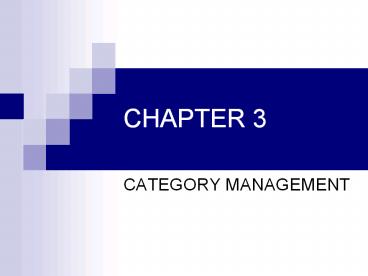CATEGORY MANAGEMENT - PowerPoint PPT Presentation
1 / 18
Title:
CATEGORY MANAGEMENT
Description:
KEY PHRASES. a strategically managed product group (defined by shopping behaviour) ... sales and profit generators. excitement creators. reinforcement of retail brand ... – PowerPoint PPT presentation
Number of Views:76
Avg rating:3.0/5.0
Title: CATEGORY MANAGEMENT
1
CHAPTER 3
- CATEGORY MANAGEMENT
2
LEARNING OBJECTIVES
- Introduce category management as an evolving
consumer-led approach to retail product
management - Become familiar with associated product
management systems, such as ECR and QR - Introduce the concept of a category and the
category life cycle - Consider the implications of CM for retail buying
organisation structures and supply partners - Outline the limitations of CM
3
CATEGORY MANAGEMENT DEFINITION
- the strategic management of product groups
through trade partnerships, which aims to
maximise sales and profits by satisfying consumer
needs (IGD, 1999) - KEY PHRASES
- a strategically managed product group (defined by
shopping behaviour) - relies on trade (supply) partnerships
- aims to maximise sales and profits (of group
rather than item)
4
ASPECTS OF CATEGORY MANAGEMENT
- A philosophy
- A process
- An organisational concept
5
CATEGORY MANAGEMENT AS A PHILOSOPHY
- Products are considered as a way to satisfy
consumer demand - Demand-pull rather than product-push
(forecasting) - Product features and procurement (buying) becomes
part of, but not focus of product management
process - Suppliers are integrated in category management
process, some become category champions
6
(No Transcript)
7
DEFINING A CATEGORY
- A category should be established by the way
consumers buy the product - Usually products in category are reasonable
substitutes for one another (e.g. fruit yoghurts) - Sometimes a category is defined by products being
complementary (e.g. exotic foods)
8
THE ROLE OF THE SKU WITHIN THE CATEGORY
- When defining the category individual roles of
SKUs (stock keeping units, or product items) are
acknowledged - traffic builders
- sales and profit generators
- excitement creators
- reinforcement of retail brand
- Products without a clear role should be
eliminated from category
9
THE STRATEGIC ROLE OF THE CATEGORY WITHIN A
RETAILERS PRODUCT ASSORTMENT (TABLE 3.2)
10
PRODUCT CATEGORY LIFE CYCLE
- The category life cycle is more useful than the
(individual product life cycle) to the retail
product manager - The different phases of the category life cycle
have implications for category management
11
IMPLICATION OF THE CATEGORY LIFE CYCLE FOR
CATEGORY MANAGEMENT
- Insert Figure 3.1
12
CATEGORY MANAGEMENT AS AN ORGANISATIONAL CONCEPT
- Category management brings a stronger marketing
orientation to product management - More cross functional role tending to reduce the
role of buying and augmenting the role of
merchandising - More involvement with store level product
management, e.g. space allocation, display and
in-store promotions - A team organisation that spans across suppliers
and retailers boundaries (see Fig. 3.3)
13
THE RETAILER-SUPPLIER INTERFACE
- Insert Figure 3.3 and acknowledgement
14
CATEGORY MANGEMENT AND ECR (Efficient Consumer
Response)
- Truly responsive product management requires
retailers supply chain (as well as retailers
buying organisation) to be responsive to consumer
demand - CM is usually part of responsive supply chain
management (e.g. ECR) - a seamless interface from customer purchase to
manufacturing schedules (Lowson et al, 1999 40) - ECR aims to maximise customer satisfaction while
minimising supply costs
15
THE PRINCIPLES OF ECR
- Insert Figure 3.4
16
THE SCOPE OF ECR
- Insert Figure 3.5
17
INFORMATION FLOW AND DATA TECHNOLOGY
- Development of ECR has been dependent on enabling
technologies - Data management and sharing across parties in
supply chain is a requirement for ECR
Insert fig 3.6
18
CATEGORY MANAGEMENT LIMITATIONS
- Category management relies on theory and jargon,
many well-run retailers have adopted the
principles of CM and ECR without the help of
consultants - Change in organisation not always possible due to
skills shortage - Retailers often have difficulty accepting
suppliers as partners - Efficient ranges have danger of becoming boring
and looking like those of competition - Smaller suppliers can be squeezed out
- Smaller retailers may not have resources to adopt
CM































